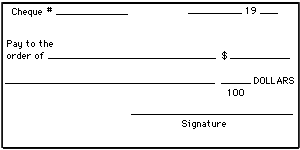Record the following numbers on an audio-cassette.
Be sure to read clearly, slowly repeating each number 3 times.
a) 9346
b) 800 008
c) 259
d) 6900
e) 202 240 273
f) 3 billion
g) 937.123
h) one hundred and one thousandths
i) 6 tenths
j) 12 million, 6 thousand six
k) one eighth
l) 3 ten thousandths
m) 35 hundredths
n) 111 thousand one hundred sixty one
Add any other number that you wish..
| NOTE: | 1. We do not use "and" as we read larger numbers: "one hundred two" NOT "one hundred and two" |
| 2. NO commas! "2000" and NOT "2,000" | |
| 3. 2000 but we use spaces for more digits - 20 000 |
On the other side of the card, write several numbers that you
wish students to read orally on cassette.
Station #2
Make place value cards such as
On the envelope write the number and the statement:
89 247: The missing card is
On their answer sheets students should write:
"The missing number is eighty nine thousand".
Station #3
Make cards as above using decimal numbers.
Station #4
Make cheque books resembling the following check blank:
Student writing: Invent name of bank, location, account number and add to check.
BILLS: make some or use some that you have that would be appropriate.

Station #5
Great way to integrate the resource centre with mathematics.
Station #6
| Use thin drinking straws for uprights. Cut these straws about 15 cm in length. Use larger drinking straws for the beads. (Straws from McDonalds work well and all you need to do is ask for straws and they are usually very generous. Larger drinking straws are sometimes available at other fast food outlets or at department and at bargain stores.) Cut them into 1-1.5 cm pieces. Insert long thin straw into a small piece of plasticine. Store each set in self sealing plastic bags. |

|
Station #7
This station helps students make the connection between math and other curricular areas. Most of the equipment is available in the science lab.
Station #8
This station integrates a grade seven science unit and geography. Encourage students to "surf the net" if it is available.
Station #8
Number tents are made with construction paper.
